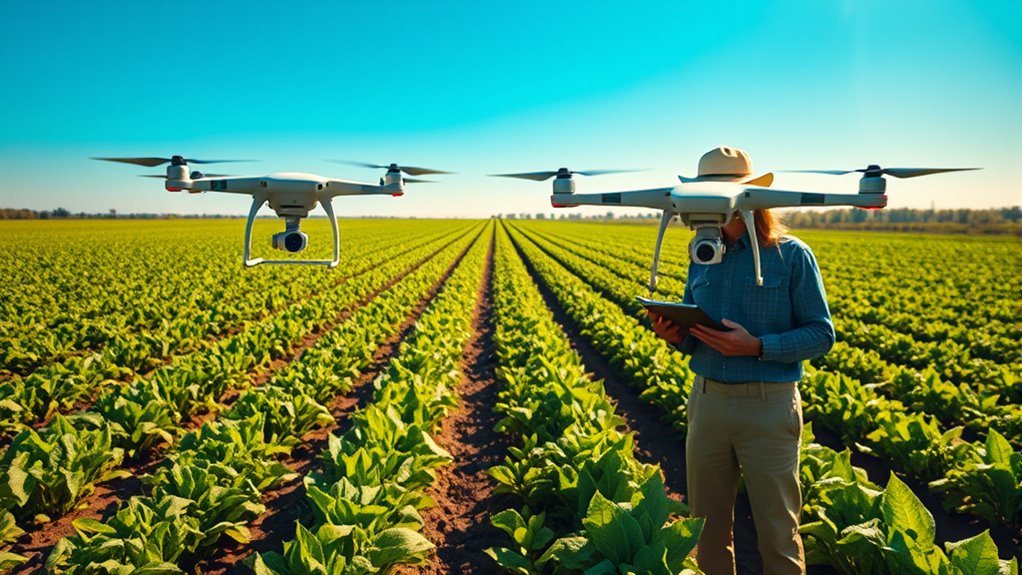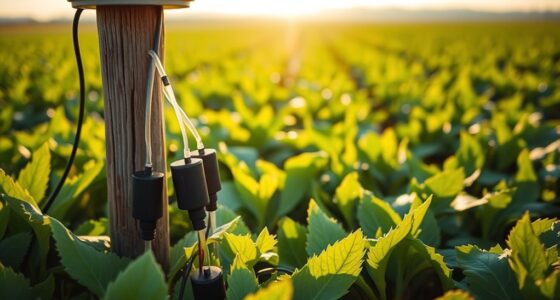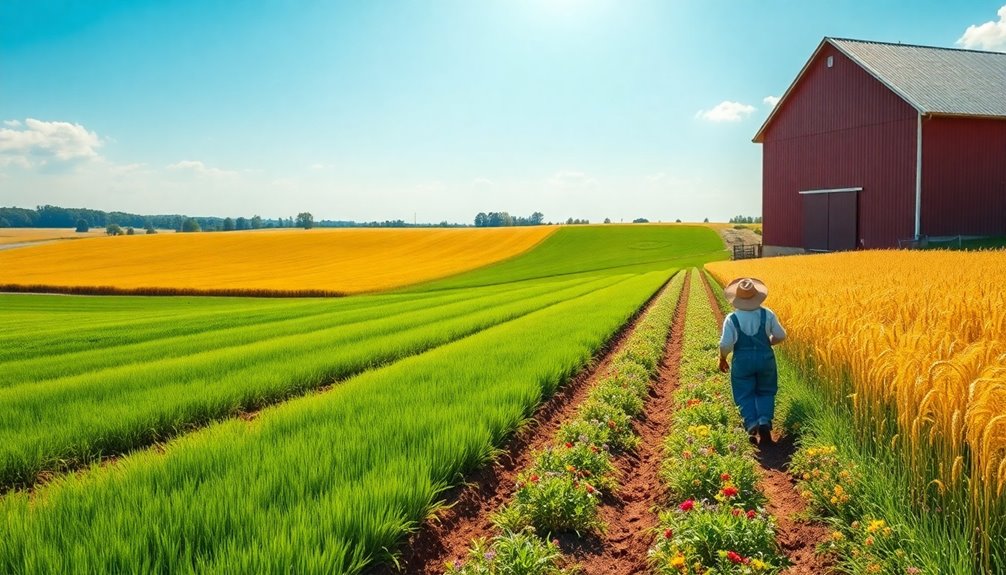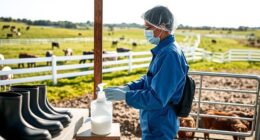E-farming is the integration of digital technologies into agriculture to boost productivity and sustainability. It uses tools like sensors, drones, and data analytics to enhance decision-making and resource optimization. You can monitor soil conditions and crop health in real time, leading to smarter farming practices. This tech not only reduces waste but also improves market access for farmers. If you're curious about the specific tech and benefits involved, there's much more to explore.
Key Takeaways
- E-farming integrates digital technologies into agriculture, enhancing efficiency and productivity through data collection and analysis.
- Key technologies include sensors, drones, AI, IoT, and satellite systems for optimized farming practices.
- It promotes sustainability by reducing resource waste and minimizing chemical use while improving crop yields.
- E-farming offers small-scale farmers better market access and reduces labor costs through automation.
- Challenges include rural connectivity issues, high initial costs, and resistance to adopting new technologies.
Definition and Overview of E-Farming
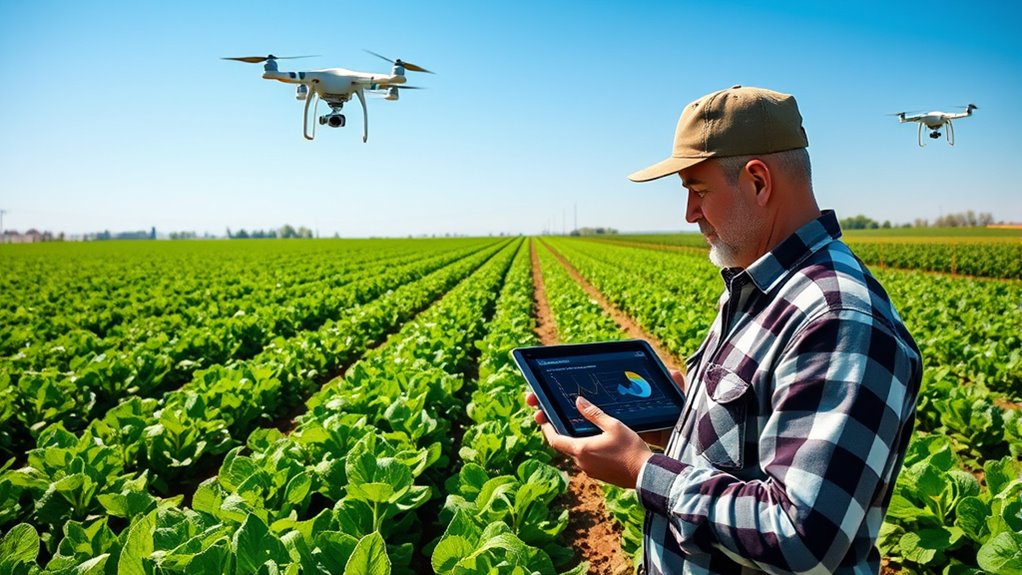
E-Farming, which integrates digital technologies into farming practices, enhances efficiency and productivity in agriculture. This concept, also known as smart farming or e-agriculture, involves the collection, storage, analysis, and sharing of electronic data.
E-Farming enhances agricultural efficiency by integrating digital technologies for data collection and analysis.
It represents a shift toward more informed and sustainable agricultural practices, often referred to as the digital agricultural revolution. By optimizing resource use and reducing waste, e-farming significantly increases productivity.
It also cuts costs through precision application of water, fertilizers, and pesticides, promoting environmental sustainability. Small-scale farmers benefit from accessible technologies and e-extension services that disseminate vital farming knowledge.
Digital platforms improve market access and provide real-time market information, ultimately leading to increased yields and better decision-making in agriculture.
Key Technologies in E-Farming
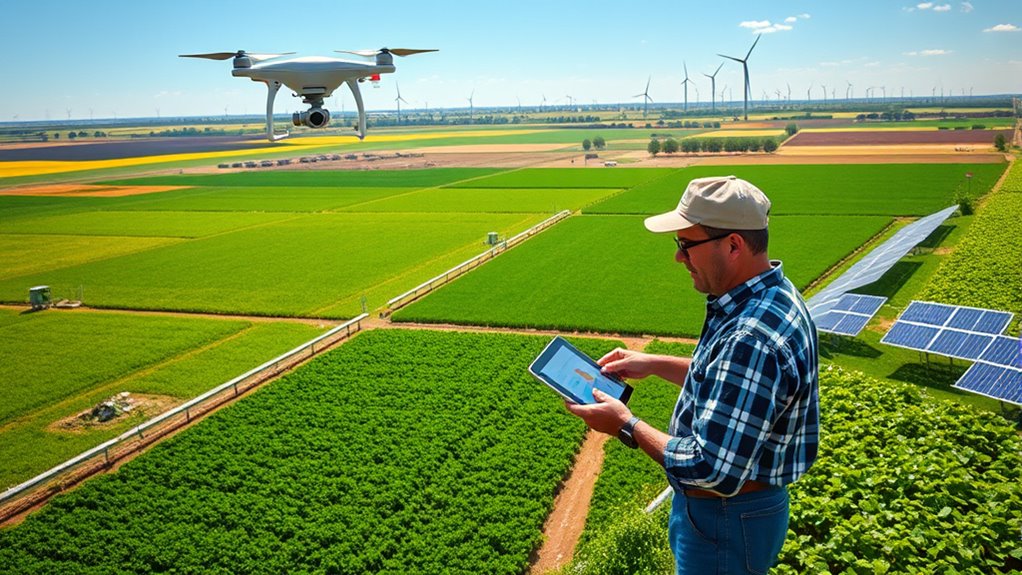
Digital technologies are transforming the agricultural landscape, making farming more efficient and productive.
Key technologies like sensors collect critical data on soil moisture, temperature, and nutrient levels, helping you monitor plant health and optimize irrigation.
Drones capture high-resolution images, allowing you to analyze crop conditions and apply inputs precisely.
Satellite technology tracks crop growth, giving you valuable insights for decision-making.
Artificial Intelligence (AI) and Machine Learning (ML) analyze data to provide tailored agronomic recommendations, continuously improving predictions.
Finally, the Internet of Things (IoT) and mobile technology enable real-time monitoring and control, making operations more accessible and efficient.
These innovations are essential for modern e-farming and can significantly enhance your agricultural practices.
Benefits of E-Farming
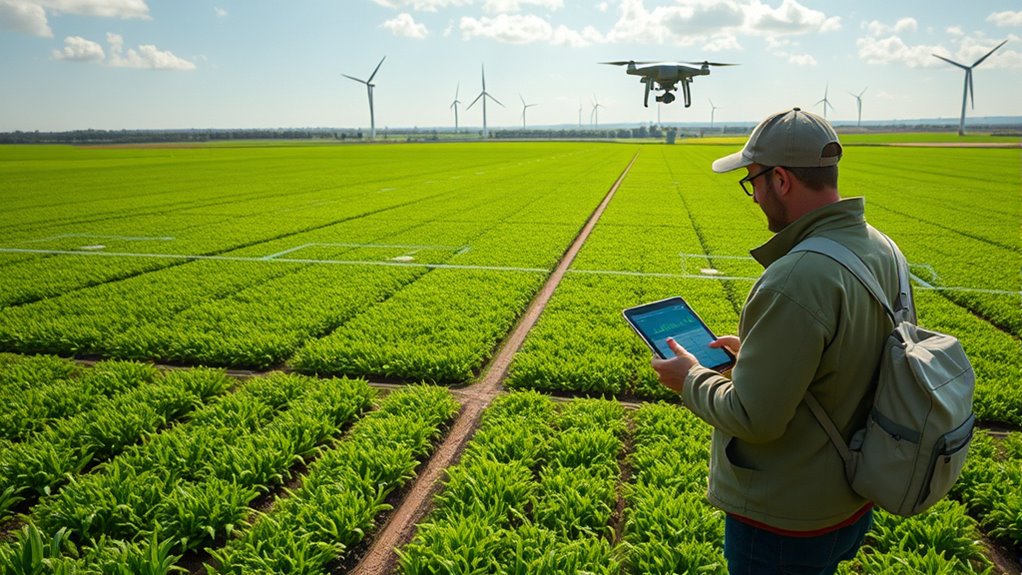
As you embrace modern agricultural practices, you'll discover that e-farming offers numerous benefits that can transform your operations.
You'll enhance efficiency and productivity through data-driven decisions, optimizing resource use with technologies like sensors and drones. This approach not only increases crop yields but also reduces labor costs by automating tasks.
Moreover, e-farming promotes sustainability by minimizing chemical use and conserving water, thus lowering your carbon footprint.
Economically, it leads to cost savings, increased income, and better market access, while also helping you manage risks effectively.
With improved traceability and quality control, you can ensure safer food products.
Challenges in Implementing E-Farming
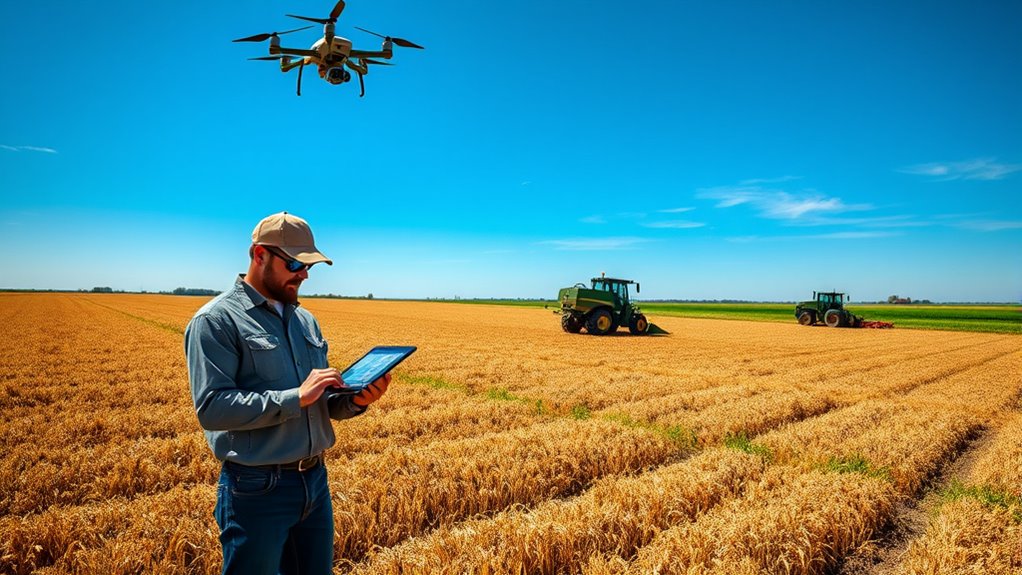
While adopting e-farming technologies can revolutionize your agricultural practices, several challenges can complicate the implementation process.
First, rural connectivity issues often hinder access to reliable internet, making it tough to utilize these technologies effectively. You might also face high initial investment costs, which can be a barrier, especially for small farmers.
Additionally, the lack of technical support and training can leave you struggling to troubleshoot and maximize the tools you invest in. Resistance to change and cultural barriers may also slow down adoption.
Finally, managing the vast amounts of data generated can be daunting, and integrating different systems poses its own set of challenges. Addressing these issues is crucial for successful e-farming implementation.
Impact on the Agricultural Sector
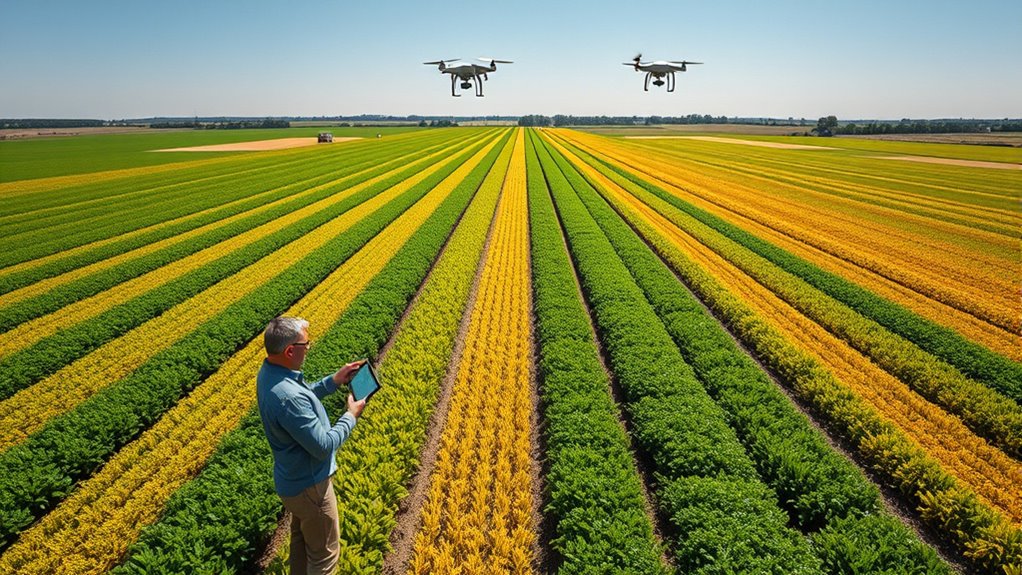
E-farming has the potential to transform the agricultural sector significantly, enhancing efficiency and sustainability. By leveraging precision agriculture, you can achieve increased yields, with reports showing a 54% boost in Argentina alone.
Technologies like Variable-Rate Application optimize resources, minimizing waste and environmental impact. Automation reduces labor costs and increases efficiency in planting and harvesting. With real-time data, you can make informed decisions about irrigation and crop management, ultimately lowering expenses.
E-farming also promotes environmental sustainability by reducing chemical use and conserving water. Moreover, it enhances market access through e-commerce, helping you expand your customer base and increase income.
Embracing these innovations gives you a competitive edge, ensuring your farm thrives in today's dynamic market.
Future of E-Farming
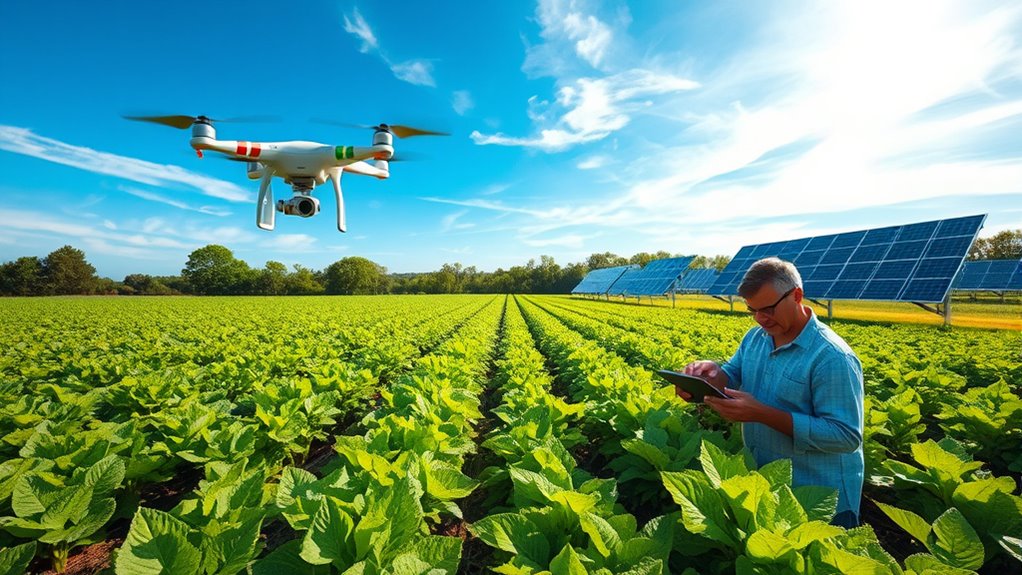
The agricultural sector stands on the brink of a technological revolution that could redefine farming practices for years to come.
You'll see Artificial Intelligence (AI) integrating into decision-making, enhancing crop management and yield predictions. Robotics and automation will streamline tasks, cutting down labor costs significantly.
With blockchain technology, transparency in supply chains will become the norm. IoT and smart sensors will collect real-time data, optimizing your farming practices. This real-time data collection aligns with the principles of resource efficiency, ensuring that every drop of water and nutrient is effectively utilized. Additionally, promoting biodiversity hotspots can enhance ecosystem resilience, which is crucial for sustainable farming.
Drones will monitor crop health, while digital twins simulate conditions for better strategies.
As you embrace these advancements, sustainability will thrive, with reduced water usage and lower chemical applications. Additionally, the integration of solar-powered irrigation systems can enhance crop yields and efficiency, supporting the overall sustainability of e-farming.
The future of e-farming promises not just efficiency, but also a commitment to environmental health and food security for an ever-growing population.
Precision Agriculture: Optimizing Crop Yields
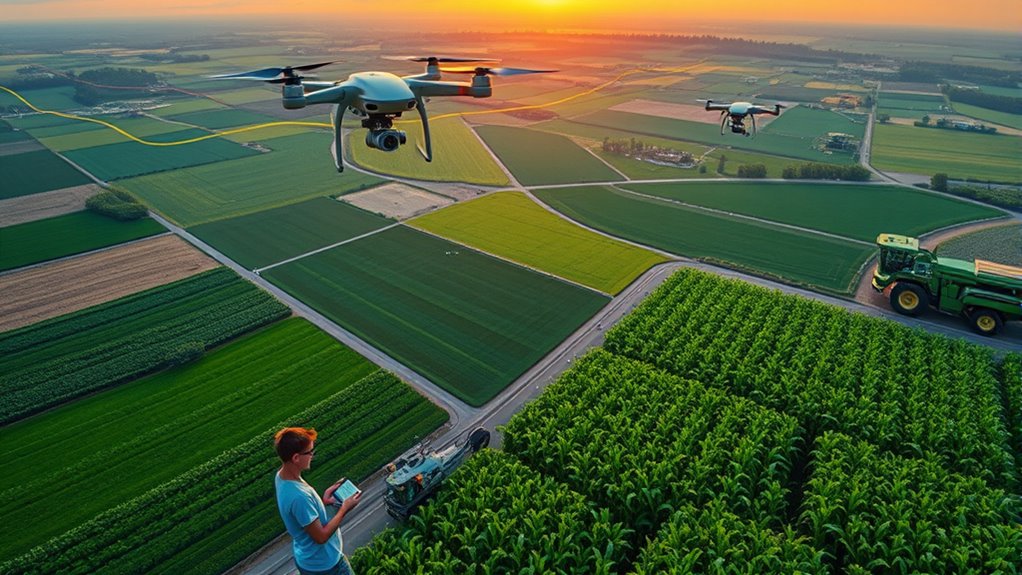
As technology continues to evolve, precision agriculture emerges as a game changer in optimizing crop yields. By utilizing GPS, GIS, and remote sensing, you can manage your fields with remarkable accuracy.
Precision agriculture revolutionizes crop management with GPS, GIS, and remote sensing for unparalleled accuracy and yield optimization.
This approach enhances resource efficiency, reducing water and fertilizer usage while increasing productivity and profitability. With sensors and IoT devices gathering real-time data, you gain valuable insights into soil conditions and crop health.
Variable Rate Technology (VRT) allows you to apply inputs strategically, ensuring each part of your field receives exactly what it needs. Decision support software analyzes this data, helping you make informed choices.
Ultimately, precision agriculture not only boosts your yields but also contributes to sustainability and reduces your environmental impact.
The Role of Drones and Aerial Imaging
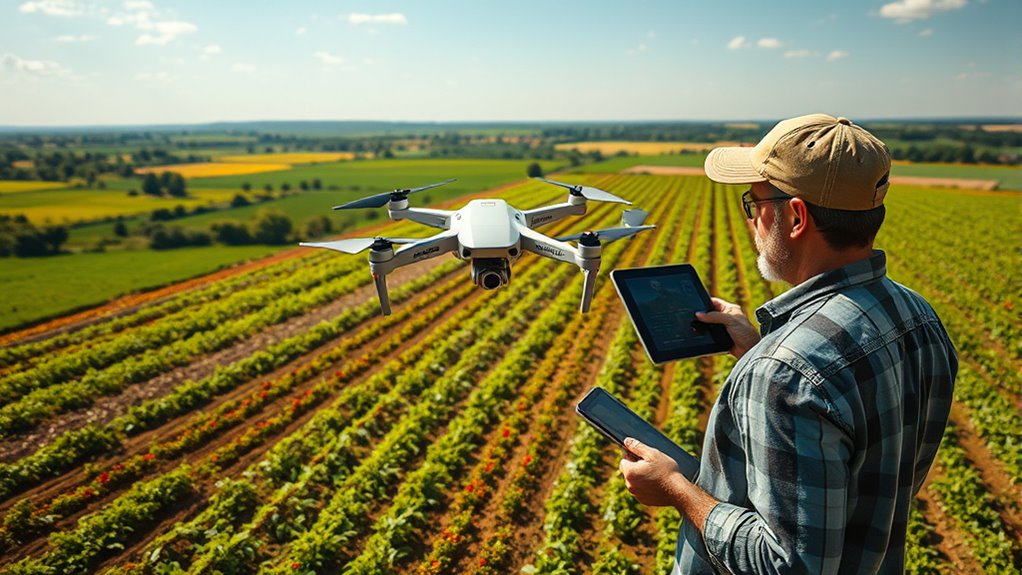
While exploring innovative solutions in agriculture, you'll find that drones and aerial imaging play a pivotal role in enhancing efficiency and decision-making.
These technologies are revolutionizing farming by providing real-time crop monitoring, allowing you to detect issues like pests early on. Drones also analyze soil conditions, optimizing your fertilizer application for better yields.
With multispectral and thermal imaging, you can identify plant stress and monitor livestock health effectively. High-resolution cameras create precise maps, guiding your planting and resource allocation.
Plus, drones reduce labor costs while improving overall farm management. As the agriculture drone market grows, embracing these tools will help you stay ahead in sustainable and efficient farming practices.
Data Analytics and Decision-Making in Agriculture
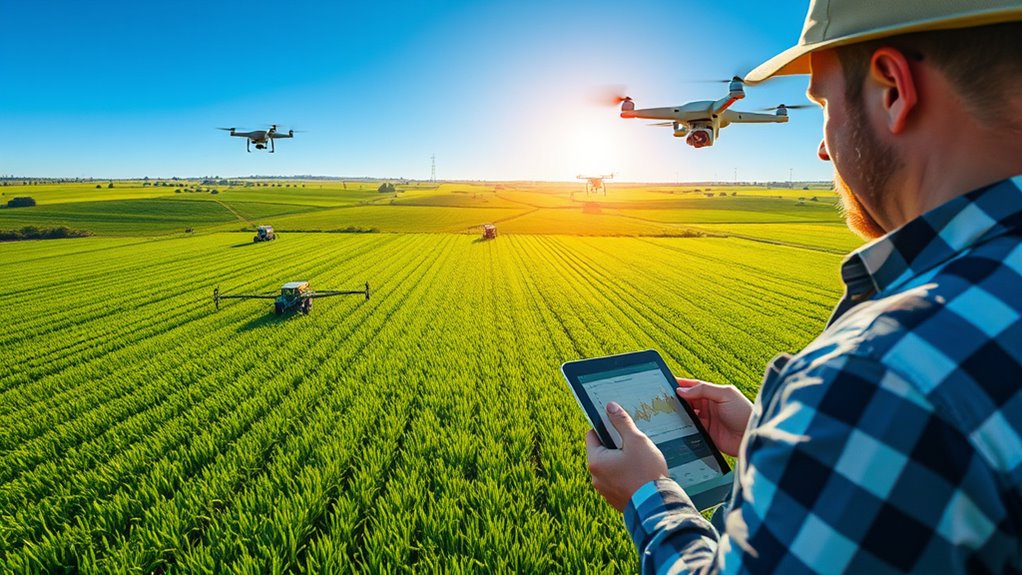
In today's agriculture, harnessing data analytics can transform your decision-making processes and significantly boost productivity. By collecting data from sensors, satellites, and weather stations, you gain valuable insights into soil health, crop conditions, and pest infestations.
Harnessing data analytics in agriculture transforms decision-making and enhances productivity through insights from sensors, satellites, and weather stations.
This information allows you to make informed decisions about irrigation, fertilization, and pest control. Integrating data from various sources enhances your ability to optimize resource allocation and tailor interventions based on specific field conditions.
Predictive analytics further supports your decision-making by forecasting future outcomes, helping you anticipate challenges and improve crop yields.
Embracing agritech tools and digital agriculture streamlines operations and aligns production with market demands, ultimately driving sustainability while mitigating risks associated with weather and market fluctuations.
Frequently Asked Questions
How Does E-Farming Affect Traditional Farming Jobs?
E-farming significantly alters traditional farming jobs by reducing the need for manual labor through automation and precision agriculture.
You'll find that while physical tasks diminish, new roles in data analysis and technology emerge, requiring specialized skills.
This shift means you'll need to adapt by developing digital literacy and technical expertise.
What Are the Environmental Risks Associated With E-Farming?
Isn't it ironic that while e-farming aims to enhance efficiency, it often harms the environment? You might find increased pesticide use contaminating soil and water, or monocultures reducing biodiversity.
Plus, greenhouse gas emissions from machinery can worsen climate change. As you embrace technology, keep in mind the resource intensity and dependence on non-renewable energy that strain local ecosystems.
Balancing innovation with sustainability is crucial for a healthier planet.
How Can Small Farmers Afford E-Farming Technologies?
To afford e-farming technologies, you can explore several strategies.
Start by seeking affordable mobile devices and low-cost alternatives to expensive equipment.
Look into innovative business models that reduce costs.
Government and NGO support can provide financial assistance, so don't hesitate to reach out.
Finally, participate in training programs to boost your digital skills, helping you effectively use these technologies and maximize their benefits for your farming operations.
What Is the Role of Government in Promoting E-Farming?
Did you know that over 70% of farmers lack access to modern technologies?
Governments play a crucial role in promoting e-farming by developing policies that guide sustainable practices and offering financial support to enhance productivity.
They also invest in digital infrastructure and training programs, ensuring you can effectively use these technologies.
Are There Privacy Concerns With Data Collected in E-Farming?
Yes, there are significant privacy concerns with data collected in e-farming.
You might worry about unauthorized access to personal and operational data, which can lead to identity theft or financial loss.
The use of AI and IoT technology means extensive data is gathered, heightening these risks.
If you're not careful, your data could be misused or inadequately protected, making it essential to understand how your information is collected, stored, and shared.
Conclusion
In conclusion, e-farming is revolutionizing agriculture like a lightning bolt striking a field, transforming how you grow and manage crops. By harnessing cutting-edge technologies, you can boost yields, streamline operations, and make smarter decisions. While challenges exist, the benefits far outweigh them, paving the way for a more sustainable future in farming. Embracing e-farming isn't just an option; it's your ticket to thriving in an ever-evolving agricultural landscape. Get ready to cultivate success!

